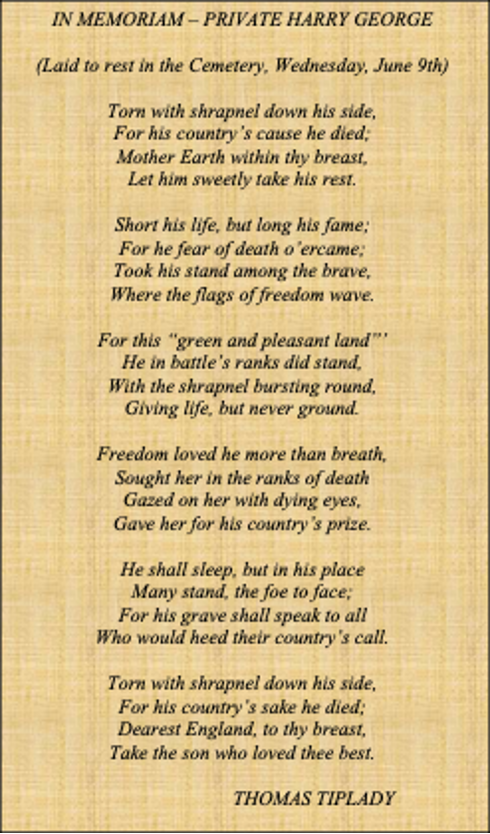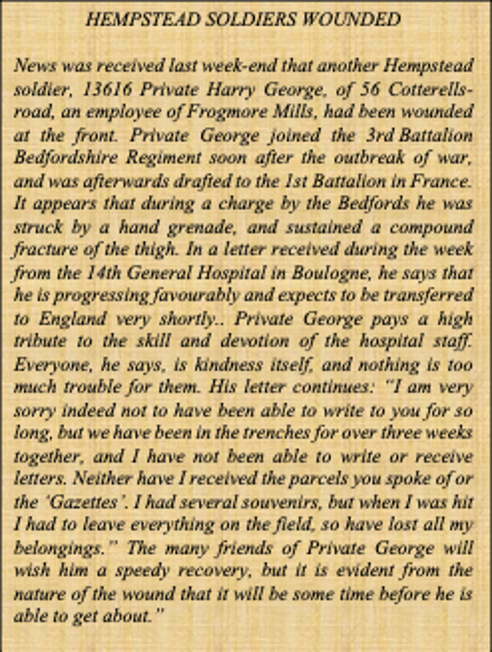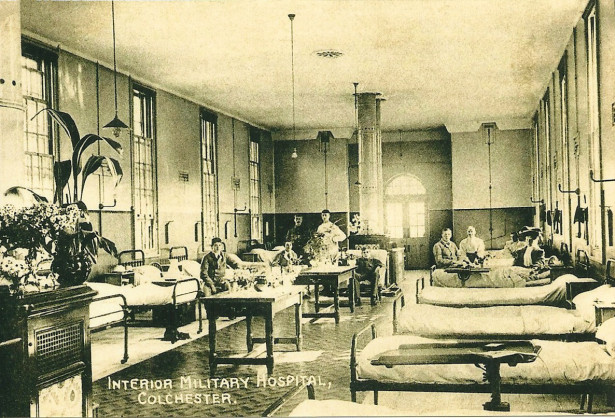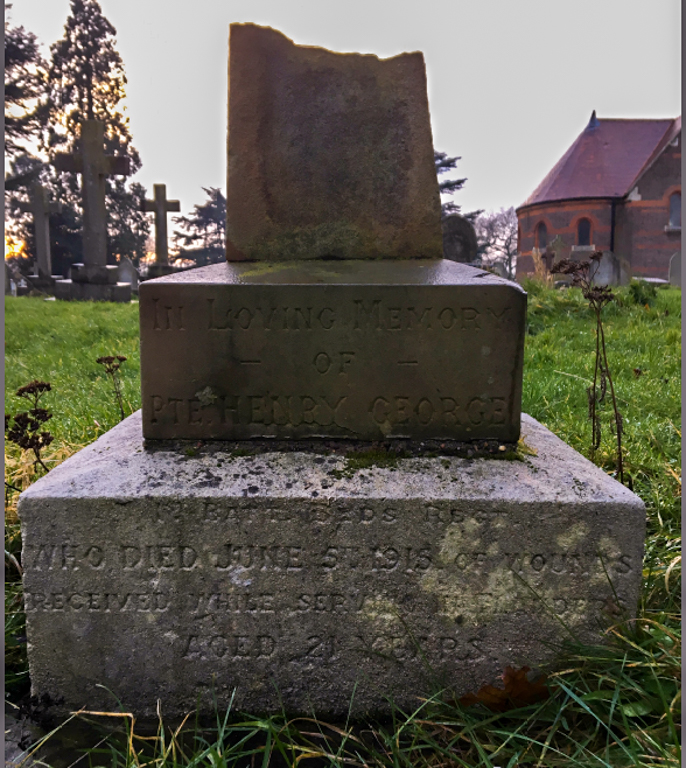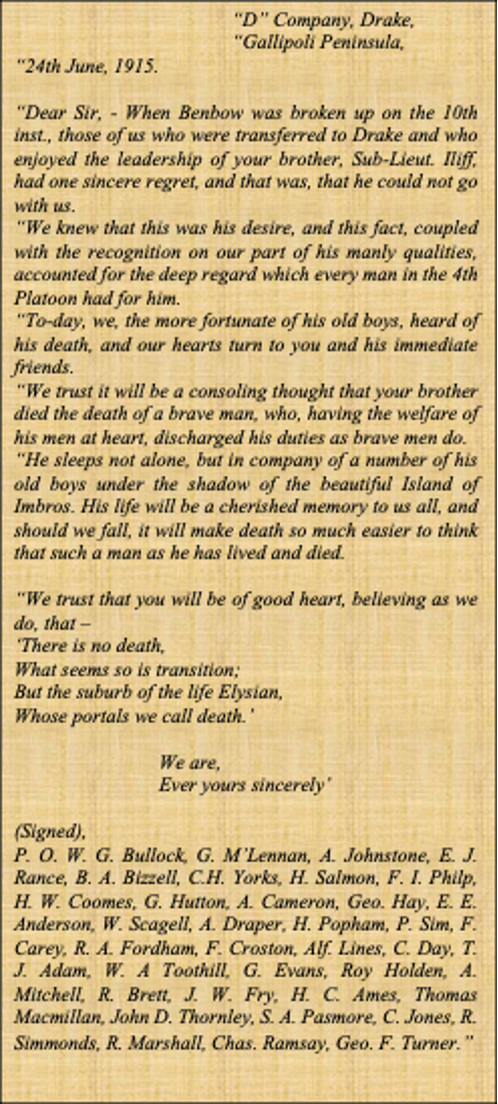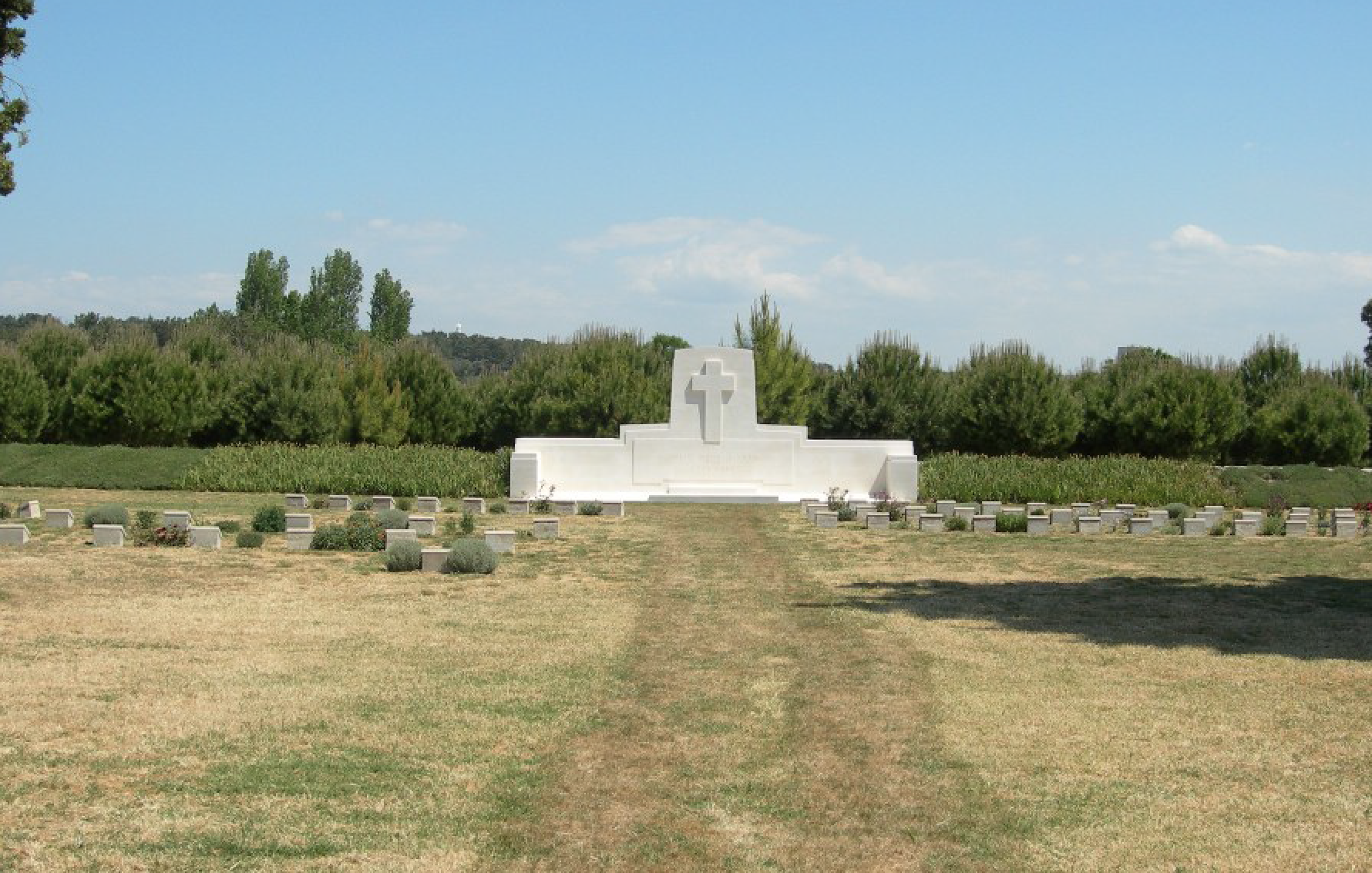Fallen in June 1915:
Henry George
Alan Chadwick Iliff
Henry
(Harry) George was born on Wednesday, 2nd May 1894 in his Uncle
Tom’s home at 56 Cotterells in Hemel Hempstead and he was baptised later the
same year on Friday, 23rd November 1894 at St Paul’s Church. His
mother Emma was twenty-eight years old when Harry was born and worked as a
Charwoman, having previously been a Straw Plaiter, a dying occupation in the
1890’s. Harry’s birth certificate does not state the identity of his father and
he was raised by his Grandmother and Aunts. His mother’s occupation as a
domestic servant meant that she ‘lived in’ at her employer’s home and depended
on her family to help with Harry’s upbringing. Emma’s employer was in fact
Cecil Sanguinetti, the Managing Director and Chairman of the British Paper
Company in Frogmore, Apsley End.
In 1901, when Harry was six years old he was living with his grandmother Mary at 39 Chapel Street in Hemel Hempstead whilst his mother was at the Sanguinetti home in St John’s Road, Boxmoor. The difference in the households could hardly have been more different and the 1901 census records that Harry’s Grandmother and one of his Aunts were receiving ’Parish Relief’, the equivalent of the modern benefits system, so clearly in impoverished circumstances.
Nevertheless, Harry grew to manhood and took up employment at the Frogmore Paper Mills where he was a General Labourer in 1911 and he lived with his Uncle Tom still at 56 Cotterells. Tom was a Blacksmith making agricultural implements, a job he did for over fifty years in the employ of Davis & Bailey at the Boxmoor Iron Works, situated in Marlowes (in the vicinity of ‘Bank Court’ today).
Harry was still working at Frogmore Mill aged twenty and had met Winifred Carpenter who worked in the Envelope Department at nearby John Dickinson. Winnie was also from Boxmoor and whilst it is not known how she met Harry, it may have been through St John’s Church in Boxmoor, where Harry was an active member. He had also pledged himself to the Church of England Temperance Society (CETS), a charity which promoted abstinence from alcohol. By the time war broke out in 1914 Harry and Winnie were sweethearts, a fact subsequently recorded in Harry’s extensive obituary published in the Hemel Gazette.
Harry was a popular young man for his Church work and his willingness to help with events such as concerts and social functions. He was described as having a cheerful nature which made him made a host of friends, and at Frogmore Mills, where he was employed he was esteemed and respected by all.
It is no surprise then that Harry was amongst the earliest recruits to the colours in August 1914, when he attested at Watford and enlisted with the 3rd Battalion Bedfordshire Regiment. Initially sent to Landguard Fort in Felixstowe to undergo basic training, Harry was subsequently posted to the 1st Battalion Bedfords in early March the following year and sent to France on 23rd March 1915.
He joined the Battalion near Ypres on the 28th March and was soon in the trenches during April, including the appalling actions at Hill 60 where the Bedfords suffered significant casualties as recorded in the war diaries: "Almost 100 Other Ranks were also killed between the 18th and 21st with several hundred more wounded.’"Having survived the initial ordeals at Hill 60, Harry then experienced the horror of "asphyxiating gas" attacks by the Germans as they retook the Hill on 5th May, where skirmishes continued for two more days.
Harry was wounded in a leg by shrapnel on the final day of action around Hill 60 and when his picture was published by the Gazette later in the year it recorded the date as the 7th May 1915.
He was
evacuated to a base hospital at Boulougne where he remained for two weeks. His
wounding was reported in the Gazette. (see extract)
Harry was
subsequently transferred to the military hospital in Sobraon Barracks at Colchester.
This was designated ‘UK Home Central Hospital’ for the admission of servicemen
direct from disembarkation.
Initially, Harry’s prospects for recovery seemed good, a view confirmed from the nature of his cheerful letters home. However, his condition deteriorated and on Saturday 5th June 1915 he underwent urgent surgery to amputate his injured leg, his only chance of survival. He rallied briefly following the operation but sadly died later the same day.
Following his death, the Hemel Gazette published an unusually long obituary (some twenty-one column inches), which included a poem dedicated to his memory by the Reverend Thomas Tiplady. The Rev. Tiplady was a chaplain to the British Expeditionary force, a prolific author, poet and hymn writer and many of his poems dedicated to the fallen appeared in the Gazette during the Great War. He preached at Marlowes Methodist Church. (see extract)
The Gazette report also recorded details of his funeral service, attendees and floral tributes. Typically, large obituary’s in the Gazette were reserved for notable public figures, so Harry’s is an indication of his popularity and the esteem in which he was held by family, friends, his employer and work colleagues. Additionally, he was the first of the fallen to ‘come home’ and he was buried with full military honours on Wednesday 9th June 1915. (see extract)
Harry is Remembered with Honour at Hemel Hempstead (Heath Lane) Cemetery, where he is interred in Grave W.27.
Harry was 21 years old when he died.
He was eligible for the 1914-15 Star, the British War Medal and the Allied Victory Medal.
Extract from The Hertfordshire, Hemel Hempstead Gazette and West Herts Advertiser 12th Jun. 1915
Henry George c 1914 (Courtesy: The Hertfordshire, Hemel Hempstead Gazette and West Herts Advertiser)
Extract from The Hertfordshire, Hemel Hempstead Gazette and West Herts Advertiser, 22nd May 1915
Colchester Military Hospital, Sobraon Barracks, Colchester during the Great War (Courtesy: Fabrizio Casale, Colchester Medical Society)
Extract from The Hertfordshire, Hemel Hempstead Gazette and West Herts Advertiser, 12th Jun. 1915
Harry George 's Headstone, Heath Lane Cemetery, Hemel Hempstead (Photos: Traquair Photography 12th Jan. 2018)
Alan
Chadwick Iliff was born in Camberwell, East Dulwich, London on Wednesday, 25th March 1885, the younger son of Captain Charles Iliff and Helen Isabella
Wilkinson. He had two older siblings, Charles Wilkinson and Elsie Cheyne. Alan’s
father Charles was a Master Mariner and records show that he was often away at
sea and as a result the family moved frequently during Alan’s younger years,
often boarding or with relatives.
In 1891 when Alan was six years old, he lived with his mother, brother and sister at 1 Ribble Terrace in Settle, Yorkshire where they were boarding. The three children were at school and Alan’s mother Helen is listed as ‘Living on own means’. Both Alan and his older brother Charles attended Giggleswick in Settle, an independent school founded in 1499. A few years later Alan had moved to Royal St Anne’s school in Redhill, Surrey where he completed his education.
By 1901 he was living at 32 Egerton Road, Chorlton-cum-Hardy, Manchester with his mother, brother and sister and aged sixteen, worked as a Printers Apprentice. His brother Charles was a Stationery Traveller, and this was the trade that would eventually bring both young men to Hemel Hempstead.
Whilst living in Manchester, Alan’s sporting talents were put to good use as a member of the Adelphi Lads Club in nearby Salford and as an oarsman with Agecroft Rowing Club in Pendleton. Alan excelled at both hockey and rowing and represented Lancashire and in later years, Hertfordshire at the former sport.
The Adelphi Lads Club was founded in 1888 to provide for the needs of lads from the deprived industrial districts of Adelphi and Greengate. However, it soon grew to include boys from all backgrounds who were attracted by the many organised sports it offered including; football, rugby, hockey, cricket, boxing and gymnastics.
1080 Adelphi lads enlisted in the Great War and Alan was one of 207 who died. The club eventually closed in 2013 after 125 years of existence.
Alan’s father Charles died at sea on the 22nd February 1903 and was subsequently buried in Brisbane, Australia without any of his family in attendance. His father bequeathed a substantial inheritance to Alan’s mother Helen, who received a settlement of £5083, the equivalent to £432,000 today.
In 1911, both Alan and his brother Charles were living at 10 Charles Street, Berkhamsted were they boarded with Mr Harry Holloway, who is described as a ‘House Decorator and Registrar of Births and Deaths’. They both worked as Stationery Manufacturers, Charles as an Assistant Manager and Alan as a Clerk, in a small business in Berkhamsted.
At the outbreak of war Alan enlisted with the Royal Naval Volunteer Reserve, having already seen some naval service before this date working his passage on tramp steamers on a number of occasions.
Despite the offer of other commissions, he preferred to enlist as an Ordinary Seaman on 9th September 1914 and was assigned to Drake Battalion of the Royal Naval Division (RND).
The RND was made up of the four existing infantry battalions of the old Marine Brigade comprising the Royal Marine Light Infantry and Royal Marine Artillery. In August 1914 Churchill the First Lord of the Admiralty, decided to embody two more naval brigades with surplus men of the Naval Reserve, to join with the Marine Brigade to produce a composite Royal Naval Division.
It formed into the 1st and 2nd Marine Brigades and the Battalions took the names of famous sailors; Drake, Benbow, Hawke, Collingwood, Nelson, Howe, Hood and Anson.
Alan underwent basic training at HMS Crystal Palace the London land based training establishment. He rose rapidly through the ranks promoted Leading Seaman on the 21st October 1914, then Petty Officer on the 23rd December of the same year. Finally, he was discharged from 1st Battalion and appointed to ‘A’ Company, 3rd (Benbow) Battalion in the 1st Brigade RND, when he was gazetted Sub-Lieutenant on the 10th March 1915.
By April 1915 the RND was part of the Mediterranean Expeditionary Force preparing for the Gallipoli campaign and Alan sailed for the Dardanelles in May 1915.
The RND suffered significant casualties during the landings at Gallipoli and in subsequent actions during April and May. As a result, the Battalions where reformed and Alan was transferred to Nelson Battalion in the 1st Brigade on 12th June after landing at Cape Helles.
He saw action throughout June at the Third Battle of Krithia and during various subsequent engagements on the Peninsula. On 20th June 1915 he was wounded whilst once again leading his men against the enemy and he subsequently died of his wounds later the same day. His death revealed the extent of the respect that his men had for Alan and two letters received by his brother Charles in July 1915 testified to this fact.
The letters came from men who had been under his command with Benbow Battalion and not only spoke of his bravery but describe their regret at losing their officer when that he had been transferred to Nelson Battalion. In all 39 men signed the two letters.
They described Alan as “one of the most manly and masterful characters” and spoke of “his willingness to go with his men through anything”. The letters were published in the Hemel Gazette in July. (see extract)
Alan is Remembered with Honour at Skew Bridge Cemetery, Canakkale, Turkey, where he is interred in Plot: II E 1. The inscription on his headstone, requested by his brother Charles, reads: “SON OF CAPTAIN CHARLES ILIFF, SUNDERLAND”
He is also commemorated in the Books of Remembrance (now lost) for the Adelphi Lads Club in Salford.
Alan was 30 years old when he died.
He was eligible for the 1914-15 Star, the British War Medal and the Allied Victory Medal.
Alan Chadwick Iliff c1914 (Courtesy: IWM, Bond of Sacrifice - First World War Portraits Collection)
Charge by the RND at Gallipoli June 1915 (Courtesy: Manchester Evening News)
Extract from The Hertfordshire, Hemel Hemspeatd Gazette and West Herts Advertiser 17th Jul. 1915
Extract from The Hertfordshire, Hemel Hempstead Gazette and West Herts Advertiser 17th Jul. 1915
Skew Bridge Cemetery, Canakkale, Turkey (Courtesy: CWGC)
